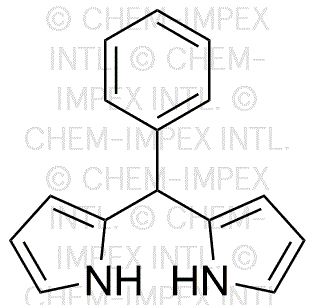5-(Phenyl)dipyrrylmethane is widely utilized in research focused on:
- Organic Electronics: This compound is used in the development of organic light-emitting diodes (OLEDs) and organic photovoltaics (OPVs), enhancing efficiency and stability in these devices.
- Fluorescent Probes: It serves as a fluorescent probe in biochemical assays, allowing researchers to visualize and track biological processes with high sensitivity.
- Photodynamic Therapy: In the medical field, it is explored for use in photodynamic therapy, where it can help target and destroy cancer cells when activated by light.
- Sensor Technology: The compound is applied in the development of sensors for detecting environmental pollutants, providing a reliable method for monitoring air and water quality.
- Research in Catalysis: It is also investigated for its potential in catalysis, offering advantages in chemical reactions that require efficient and selective processes.
General Information
Properties
Safety and Regulations
Applications
5-(Phenyl)dipyrrylmethane is widely utilized in research focused on:
- Organic Electronics: This compound is used in the development of organic light-emitting diodes (OLEDs) and organic photovoltaics (OPVs), enhancing efficiency and stability in these devices.
- Fluorescent Probes: It serves as a fluorescent probe in biochemical assays, allowing researchers to visualize and track biological processes with high sensitivity.
- Photodynamic Therapy: In the medical field, it is explored for use in photodynamic therapy, where it can help target and destroy cancer cells when activated by light.
- Sensor Technology: The compound is applied in the development of sensors for detecting environmental pollutants, providing a reliable method for monitoring air and water quality.
- Research in Catalysis: It is also investigated for its potential in catalysis, offering advantages in chemical reactions that require efficient and selective processes.
Documents
Safety Data Sheets (SDS)
The SDS provides comprehensive safety information on handling, storage, and disposal of the product.
Product Specification (PS)
The PS provides a comprehensive breakdown of the product’s properties, including chemical composition, physical state, purity, and storage requirements. It also details acceptable quality ranges and the product's intended applications.
Certificates of Analysis (COA)
Search for Certificates of Analysis (COA) by entering the products Lot Number. Lot and Batch Numbers can be found on a product’s label following the words ‘Lot’ or ‘Batch’.
*Catalog Number
*Lot Number
Certificates Of Origin (COO)
This COO confirms the country where the product was manufactured, and also details the materials and components used in it and whether it is derived from natural, synthetic, or other specific sources. This certificate may be required for customs, trade, and regulatory compliance.
*Catalog Number
*Lot Number
Safety Data Sheets (SDS)
The SDS provides comprehensive safety information on handling, storage, and disposal of the product.
DownloadProduct Specification (PS)
The PS provides a comprehensive breakdown of the product’s properties, including chemical composition, physical state, purity, and storage requirements. It also details acceptable quality ranges and the product's intended applications.
DownloadCertificates of Analysis (COA)
Search for Certificates of Analysis (COA) by entering the products Lot Number. Lot and Batch Numbers can be found on a product’s label following the words ‘Lot’ or ‘Batch’.
*Catalog Number
*Lot Number
Certificates Of Origin (COO)
This COO confirms the country where the product was manufactured, and also details the materials and components used in it and whether it is derived from natural, synthetic, or other specific sources. This certificate may be required for customs, trade, and regulatory compliance.


